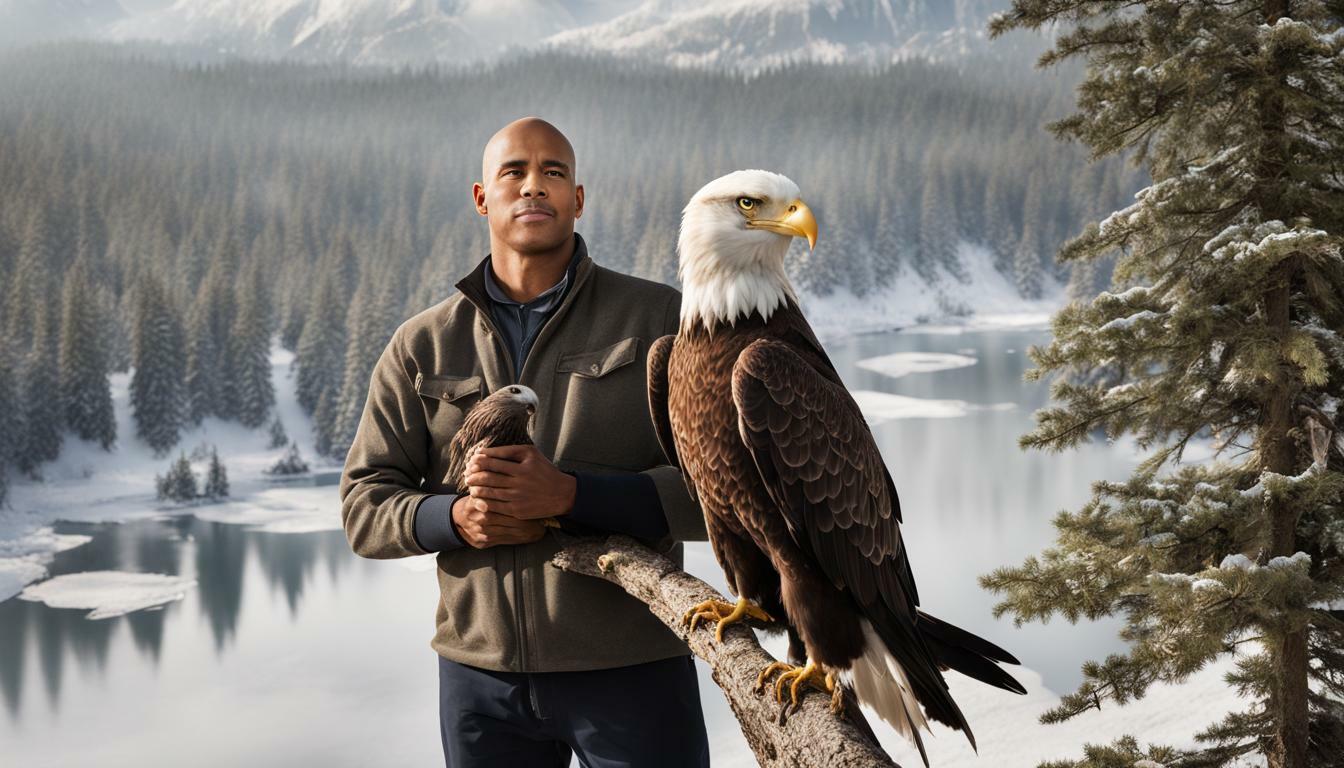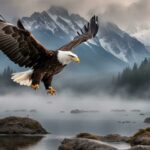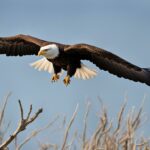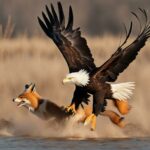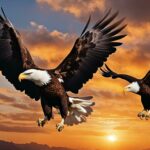If you’re a falconer or interested in pursuing falconry, you may be wondering if you can own a bald eagle. Bald eagles are iconic birds of prey that hold a special place in American culture, but as a protected species under the Bald and Golden Eagle Protection Act, owning one requires certain permits, licenses, and regulations.
In this article, we’ll explore the legalities of owning a bald eagle as a falconer, as well as the responsibilities and requirements involved in caring for these magnificent birds.
Key Takeaways:
- As a protected species, owning a bald eagle as a falconer requires certain permits and licenses.
- Specific regulations and ownership rules must be followed to ensure the well-being of the bird.
- Falconers also have a responsibility to contribute to bald eagle conservation efforts and educate the public about these majestic birds.
The Legalities of Owning Bald Eagles as a Falconer
If you’re a falconer interested in owning a bald eagle, it’s important to understand the legalities involved. Owning a bald eagle, a federally protected bird, requires specific permits and licenses.
The Bald and Golden Eagle Protection Act and the Migratory Bird Treaty Act are two federal laws that govern the ownership of bald eagles. According to these laws, only individuals who hold a valid falconry permit and have completed the necessary training and education can own a bald eagle.
| Requirements for Owning a Bald Eagle as a Falconer: |
|---|
| – A valid falconry permit |
| – Completed training and education in the care and handling of bald eagles |
| – Approval from the U.S. Fish and Wildlife Service |
To obtain a bald eagle for falconry purposes, falconers must first apply for a permit with the U.S. Fish and Wildlife Service. The application process involves demonstrating the necessary knowledge and experience required to care for a bald eagle, as well as providing details on the housing, training, and conservation efforts that will be undertaken to ensure the bird’s welfare.
The Legal Responsibilities of Owning a Bald Eagle as a Falconer
Once granted a permit, falconers must adhere to strict regulations and guidelines when owning a bald eagle. This includes providing adequate housing, nutrition, and medical care, as well as following specific training and handling protocols to ensure the bird’s safety and well-being.
Falconers must also report any injuries or deaths involving their bald eagles and undergo regular inspections to ensure compliance with federal and state regulations. Failure to comply with these regulations can result in the revocation of the falconry permit and legal consequences.
It’s important for falconers to understand and follow the legal requirements and responsibilities associated with owning a bald eagle. By doing so, they can continue to enjoy the beauty and majesty of these birds through the ancient practice of falconry while also contributing to the conservation efforts to protect and preserve this iconic species.
Obtaining Bald Eagles as a Falconer
If you’re interested in owning a bald eagle as a falconer, there are specific steps you must follow to ensure compliance with federal and state regulations. It’s important to note that not all falconers may be eligible for a permit allowing them to own a bald eagle, and permits are limited in number.
The first step in obtaining a bald eagle as a falconer is to acquire the necessary permits and licenses. This typically involves obtaining a state falconry permit, a federal falconry permit, and a permit specifically for bald eagle ownership. You’ll need to demonstrate a high level of experience and knowledge in falconry before these permits are granted.
| Permit/License | Issued By | Requirements |
|---|---|---|
| State Falconry Permit | State Wildlife Agency | Completion of an approved apprenticeship and passing a written exam |
| Federal Falconry Permit | U.S. Fish and Wildlife Service | Completion of an approved apprenticeship, passing a written exam, and meeting federal regulations and standards |
| Bald Eagle Ownership Permit | U.S. Fish and Wildlife Service | Completing a detailed application and demonstrating exceptional knowledge and experience in falconry |
After obtaining the necessary permits and licenses, you’ll need to find a suitable bald eagle to acquire. It’s important to remember that you cannot take a bald eagle from the wild – all birds must be obtained through a licensed breeder or rehabilitator.
Bald eagles are highly regulated, and it’s essential that you maintain accurate records and adhere to all reporting requirements. This includes keeping detailed records of the acquisition and transfer of the bird, as well as regular reporting on the bird’s health, training, and overall well-being.
Ownership Rules for Falconers and Bald Eagles
As a falconer, it is essential to understand the specific ownership rules and restrictions that come with owning a bald eagle. These rules are in place to ensure the well-being of the bird and protect their population. Here are some essential ownership rules you should know:
| Rule | Description |
|---|---|
| Housing requirements | Bald eagles must have adequate space to move around and exercise. Their enclosure must be of sufficient size to allow them to stretch their wings without obstruction. |
| Training protocols | Falconers must use humane and ethical training methods to work with their birds. Methods that involve physical harm or discomfort to the bird are strictly prohibited. |
| Transport regulations | When transporting a bald eagle, falconers must ensure their safety and comfort. They must be transported in a secure container and provided with adequate food and water during the journey. |
| Reporting requirements | Falconers must report any injuries or deaths of their birds to the appropriate authorities. They must also maintain accurate records of the bird’s health, training, and other pertinent information. |
It is crucial to adhere to these ownership rules and any other regulations set forth by relevant authorities to ensure the welfare of the bird and avoid any legal consequences. By providing a safe and suitable environment and following ethical training techniques, you can enjoy a successful and rewarding experience as a falconer with a bald eagle.
Responsibilities of Falconers with Bald Eagles
As a falconer who owns a bald eagle, you have a crucial responsibility to ensure the wellbeing and protection of this majestic bird. To fulfill this responsibility, you must be prepared to undertake the following tasks:
- Provide proper care: You must provide your bald eagle with proper housing, nutrition, and medical care. This includes regular check-ups by a licensed veterinarian who specializes in birds of prey.
- Train your eagle: Proper training is vital to ensure the safety of both the bird and the falconer. You must have the necessary skills to train your eagle to hunt and fly safely and effectively.
- Practice conservation: As a falconer who owns a bald eagle, you have a unique opportunity to contribute to the conservation of this iconic species. You should actively participate in initiatives that support the recovery and sustainability of the bald eagle population.
In addition to these responsibilities, you must also be aware of the reporting and oversight requirements for owning a bald eagle as a falconer. You must keep accurate records, undergo regular inspections, and comply with federal and state agencies to ensure the proper care and maintenance of your bird.
By fulfilling these responsibilities, you can build a strong bond with your bald eagle, contribute to conservation efforts, and enjoy the rewards of practicing falconry with one of the most majestic birds of prey in the world.
Training and Handling Techniques for Bald Eagles
Training and handling a bald eagle requires a significant amount of experience, skill, and patience. As a falconer, you must start by building trust and a strong bond with your bird. This process begins with the bird’s initial acclimation to its new environment, as you introduce it to its new surroundings and establish a routine for feeding and care.
Falconry equipment is essential to ensure effective training and handling of your bald eagle. You will need specialized equipment such as jesses, anklets, and leashes to safely restrain and control your bird during training and transportation.
You will also need to establish a training regime tailored to your bird’s temperament and abilities. This involves a range of exercises that help the bird to develop its hunting skills and optimize its flyweight. You will need to create a positive reinforcement environment, rewarding the bird for good behavior and progress.
It is important to note that handling and training a bald eagle is not a solitary endeavor. Falconers often work with other bird trainers and participate in falconry events to learn new techniques and get advice from experienced professionals.
In addition, it is essential to prioritize the bird’s welfare and safety at all times. Proper care and training will help ensure the bird stays healthy and happy, and you as the falconer will be able to witness the beauty of these magnificent creatures.
Conservation Efforts for Bald Eagles
As a falconer who owns a bald eagle, you play a crucial role in the conservation of this magnificent bird. By keeping a bald eagle, you are contributing to the recovery and sustainability of the species. You can take pride in knowing that you are making a difference in the efforts to protect and preserve the bald eagle population.
Falconers participate in various conservation initiatives to ensure the welfare of the birds. One such program is the hacking program, where young bald eagles are raised in captivity and then released into the wild to increase the population. Falconers also participate in research programs to study the behavior and habitat of bald eagles, which provide valuable information for conservation efforts.
Aside from the direct efforts, falconry also plays a vital role in educating the public about the importance of bald eagle conservation. Through public demonstrations and educational programs, you can raise awareness about the needs of this iconic species and the role that falconry plays in its conservation.
Your commitment to these conservation efforts is essential to ensure the long-term survival of the bald eagle. As a falconer, you have a unique opportunity to contribute to the conservation of one of America’s most majestic birds.
Reporting and Oversight for Bald Eagle Ownership
As a falconer, it is essential to understand the reporting and oversight requirements when owning a bald eagle. The Bald and Golden Eagle Protection Act and the Migratory Bird Treaty Act protect these birds, and falconers must adhere to federal and state regulations to ensure they are adequately cared for.
Falconers must keep detailed records of their bald eagle’s health, housing, and diet to comply with authorities. These records are subject to inspection by the United States Fish and Wildlife Service (USFWS) to ensure that all regulations are followed.
Additionally, falconers must allow USFWS officials to regularly inspect their facilities to ensure that the bald eagle’s housing meets the required standards. This includes proper perching, ventilation, and protection from extremes of weather.
It is also important to note that reporting requirements vary by state. Some states may require falconers to report their acquisition and release of a bald eagle to state wildlife authorities.
Violation of any of these regulations can lead to severe penalties, including fines and imprisonment. It is therefore essential to maintain accurate records and comply with all reporting and oversight requirements.
Educational Programs and Public Engagement
As a falconer with a bald eagle, you are part of a larger community dedicated to raising awareness about these majestic birds and their conservation needs. Educational programs and public engagement activities play a vital role in spreading knowledge and appreciation for these creatures, and as a falconer, you have the opportunity to be a key player in these efforts.
One way to get involved is by participating in local schools and community events. Sharing your knowledge and experiences with students and the public can help spark interest and understanding about the importance of conservation efforts and the role falconers play in protecting the bald eagle population.
You can also consider joining a falconry association or organization in your area. These groups often offer educational programs and events, as well as opportunities to network with other falconers and participate in conservation initiatives.
Another way to engage with the public is through social media and online platforms. Sharing photos and stories of your experiences with your bald eagle can help inspire others to learn more about falconry and the importance of conservation efforts.
Ultimately, your involvement in educational programs and public engagement activities can help make a difference in protecting and preserving the bald eagle population for future generations.
Conclusion
Congratulations! You have reached the end of our informative guide on owning bald eagles as a falconer. We hope that this article has shed light on the various legalities, ownership rules, and responsibilities involved in falconry with these magnificent birds.
Remember, it is crucial to understand the requirements involved in owning a bald eagle as a falconer. This includes obtaining the necessary permits and licenses, complying with housing and training regulations, and adhering to reporting and oversight requirements.
As a falconer, you have a unique opportunity to contribute to the conservation efforts for the bald eagle population. By participating in educational programs and public engagement activities, you can help raise awareness about the importance of protecting and preserving these iconic birds.
If you are considering pursuing falconry with bald eagles, we encourage you to seek professional guidance and further resources to ensure that you are fully equipped to undertake this responsibility.
Thank you for reading and happy falconry!
Can Falconers Keep Birds of Prey as Pets in Rental Properties?
Falconers face challenges when keeping birds of prey as pets in rental properties. Landlords might find it difficult to accommodate the specific needs of these birds, such as large flight enclosures, noise considerations, and potential damage. Additionally, certain regulations may restrict the keeping of birds as pets in rental properties due to safety or legal concerns.
FAQ
Q: Can falconers have bald eagles?
A: Yes, falconers have the opportunity to own and work with bald eagles, but it is subject to specific regulations and requirements.
Q: What are the requirements for falconers to have bald eagles?
A: Falconers must obtain the necessary permits and licenses, meet housing requirements, and adhere to training and handling protocols to have bald eagles.
Q: What are the regulations for owning bald eagles as a falconer?
A: Falconers must comply with federal and state regulations, including reporting, record-keeping, and overseeing requirements for the ownership of bald eagles.
Q: How can falconers legally acquire a bald eagle for falconry purposes?
A: Falconers can legally acquire a bald eagle through the appropriate permits and licenses issued by the relevant authorities overseeing falconry and wildlife regulations.
Q: What are the ownership rules for falconers and bald eagles?
A: Falconers must follow specific ownership rules, including providing suitable housing, implementing proper training protocols, and adhering to additional regulations for the well-being of the bald eagles.
Q: What responsibilities do falconers have when owning bald eagles?
A: Falconers have the responsibility to provide proper care, training, and conservation efforts to ensure the welfare and protection of their bald eagles.
Q: What training and handling techniques do falconers use for bald eagles?
A: Falconers utilize specialized training techniques, employ falconry equipment, and focus on building a strong bond between themselves and the bald eagles to facilitate successful falconry practices.
Q: How do falconers contribute to the conservation efforts for bald eagles?
A: Falconers actively participate in conservation initiatives, supporting the recovery and sustainability of bald eagle populations through their dedication to falconry and educational outreach.
Q: What reporting and oversight requirements must falconers adhere to for bald eagle ownership?
A: Falconers must maintain accurate records, comply with inspections, and meet reporting requirements set by federal and state agencies to ensure proper care and management of their bald eagles.
Q: How do falconers engage in educational programs and public engagement for bald eagles?
A: Falconers play an essential role in educating the public, schools, and communities about bald eagles and their conservation needs through various educational programs and public engagement activities.

